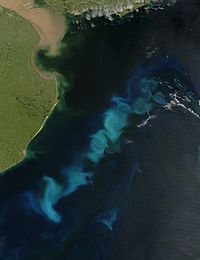
Photo from wikipedia
Elevated suspended sediment concentrations (SSCs) often impact coral fertilisation success, but sediment composition can influence effect thresholds, which is problematic for accurately predicting risk. Here, we derived concentration-response thresholds and… Click to show full abstract
Elevated suspended sediment concentrations (SSCs) often impact coral fertilisation success, but sediment composition can influence effect thresholds, which is problematic for accurately predicting risk. Here, we derived concentration-response thresholds and cause-effect pathways for SSCs comprising a range of realistic mineral and organic compositions on coral fertilisation success. Effect concentration thresholds (EC10: 10% fertilisation inhibition) varied markedly, with fertilisation highly sensitive to inshore organic-clay rich sediments and bentonite clay at <5 mg L-1. Mineral clays and organic matter within these sediments likely promoted flocculation of the coral sperm, which in turn reduced fertilisation. In contrast, sediments lacking these properties bound less sperm, leading to higher SSC thresholds for coral fertilisation (EC10 > 40 mg L-1). The effect thresholds for relevant sediment types were combined with in situ turbidity data from locations near dredging operations to assess the risks posed by dredging to coral fertilisation at these locations.
Journal Title: Marine pollution bulletin
Year Published: 2018
Link to full text (if available)
Share on Social Media: Sign Up to like & get
recommendations!